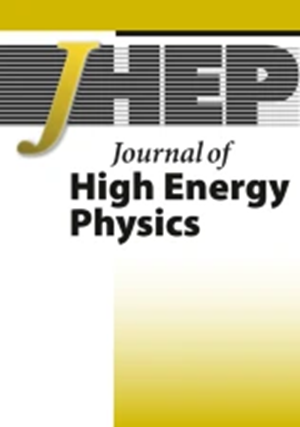Krylov complexity in the IP matrix model
IF 5.5
1区 物理与天体物理
Q1 PHYSICS, PARTICLES & FIELDS
引用次数: 9
Abstract
A bstract The IP matrix model is a simple large N quantum mechanical model made up of an adjoint harmonic oscillator plus a fundamental harmonic oscillator. It is a model introduced previously as a toy model of the gauge theory dual of an AdS black hole. In the large N limit, one can solve the Schwinger-Dyson equation for the fundamental correlator, and at sufficiently high temperature, this model shows key signatures of thermalization and information loss; the correlator decay exponentially in time, and the spectral density becomes continuous and gapless. We study the Lanczos coefficients b n in this model and at sufficiently high temperature, it grows linearly in n with logarithmic corrections, which is one of the fastest growth under certain conditions. As a result, the Krylov complexity grows exponentially in time as $$ \sim \exp \left(\mathcal{O}\left(\sqrt{t}\right)\right) $$IP矩阵模型中的Krylov复杂度
IP矩阵模型是一个简单的大N量子力学模型,由一个伴随谐振子和一个基谐振子组成。这是一个以前作为标准理论对偶黑洞的玩具模型介绍的模型。在大N极限下,可以求解基本相关器的Schwinger-Dyson方程,并且在足够高的温度下,该模型显示出热化和信息损失的关键特征;相关器随时间呈指数衰减,谱密度变为连续无间隙。我们在该模型中研究了Lanczos系数bn,在足够高的温度下,它随n的对数修正线性增长,是在一定条件下增长最快的一种。因此,Krylov复杂度随时间呈指数增长,为$$ \sim \exp \left(\mathcal{O}\left(\sqrt{t}\right)\right) $$ ~ exp O t。这些结果表明,在足够高的温度下,IP模型是混沌的。
本文章由计算机程序翻译,如有差异,请以英文原文为准。
求助全文
约1分钟内获得全文
求助全文
来源期刊

Journal of High Energy Physics
PHYSICS, PARTICLES & FIELDS-
CiteScore
10.00
自引率
46.30%
发文量
2107
审稿时长
12 weeks
期刊介绍:
The aim of the Journal of High Energy Physics (JHEP) is to ensure fast and efficient online publication tools to the scientific community, while keeping that community in charge of every aspect of the peer-review and publication process in order to ensure the highest quality standards in the journal.
Consequently, the Advisory and Editorial Boards, composed of distinguished, active scientists in the field, jointly establish with the Scientific Director the journal''s scientific policy and ensure the scientific quality of accepted articles.
JHEP presently encompasses the following areas of theoretical and experimental physics:
Collider Physics
Underground and Large Array Physics
Quantum Field Theory
Gauge Field Theories
Symmetries
String and Brane Theory
General Relativity and Gravitation
Supersymmetry
Mathematical Methods of Physics
Mostly Solvable Models
Astroparticles
Statistical Field Theories
Mostly Weak Interactions
Mostly Strong Interactions
Quantum Field Theory (phenomenology)
Strings and Branes
Phenomenological Aspects of Supersymmetry
Mostly Strong Interactions (phenomenology).
 求助内容:
求助内容: 应助结果提醒方式:
应助结果提醒方式:


